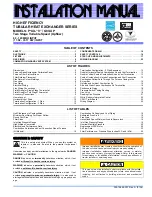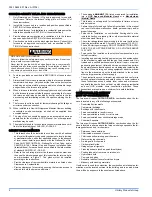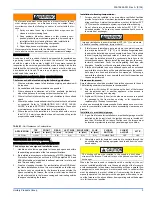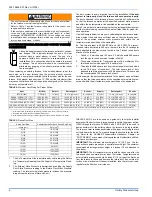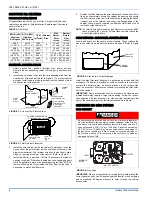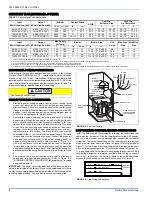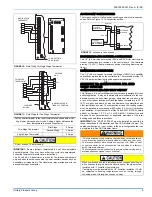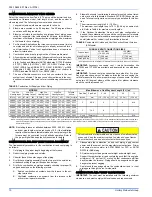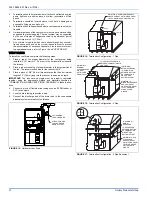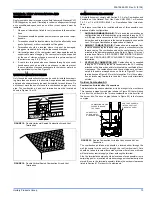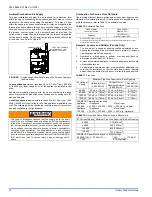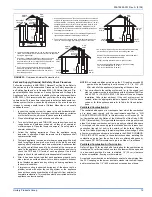
035-19624-001 Rev. A (0104)
Unitary Products Group
13
VERTICAL VENT APPLICATIONS AND
TERMINATION
Roof mounted vertical terminals may be field fabricated. Standard PVC/
SRD fittings may be used. If installing a vertical venting system through
any unconditioned space such as an attic or crawl space it must be
insulated.
1.
Observe all clearances listed in vent clearances in these instruc-
tions.
2.
Termination should be positioned where vent vapors are not objec-
tionable.
3.
Termination should be located where it will not be affected by wind
gusts, light snow, or allow recirculation of flue gases.
4.
Termination should be located where it cannot be damaged,
plugged or restricted by tree limbs, leaves and branches.
5.
Horizontal portions of the vent system must slope upwards and be
supported to prevent sagging. The vent system may be supported
by the use of clamps or hangers secured to a permanent part of
the structure every 4 ft. (1.22 m).
6.
A vent drain is required when vent passes through any uncondi-
tioned space such as an attic or crawl space in order to prevent
the accumulation of excess condensate in the inducer motor dur-
ing operational cycles. See Figure 14.
VENTING MULTIPLE UNITS
Only the sealed combustion system can be used for installations requir-
ing more than one furnace in a structure. A separate sealed combustion
air pipe and a separate vent pipe must be installed for each furnace. Do
not connect more than one furnace to a combustion air pipe or a vent
pipe. The combustion air and vent termination must be located as
shown in Figures 18 or 19.
COMBUSTION AIR SUPPLY
All installations must comply with Section 5.3, Air for Combustion and
Ventilation of the National Fuel Gas Code, ANSI Z223.1 or Sections
7.2, 7.3 or 7.4 of CAN/CGA B149.1 or .2 Installation Code - latest edi-
tions.
This furnace is certified to be installed with one of three possible com-
bustion air intake configurations.
1.
OUTDOOR COMBUSTION AIR:
This is a sealed combustion air
configuration where the combustion air is supplied through a PVC
or ABS pipe that is connected to the PVC coupling attached to the
burner box and is terminated in the same atmospheric zone as the
vent. This type of installation is approved on all models
2.
AMBIENT COMBUSTION AIR:
Combustion air is supplied from
the area surrounding the furnace through vents or knockouts in the
furnace casing. The combustion air and the vent pipes are not ter-
minated in the same atmospheric zone. Refer to Figure 21 for vent
terminations. Refer to “AIR SOURCE FROM INSIDE THE BUILD-
ING” and “VENT AND SUPPLY AIR SAFETY CHECK” for proper
installation.
3.
VENTILATED COMBUSTION AIR:
Combustion air is supplied
through a PVC or ABS pipe that is connected to the PVC coupling
attached to the burner box and is terminated in a ventilated attic or
crawl space. The combustion air and the vent pipes are not termi-
nated in the same atmospheric zone. Refer to Figure 23 for vent
terminations and Figure 23 for attic termination. Only the combus-
tion air intake may terminate in the attic. The vent must terminate
outside.
Outdoor Combustion Air
Combustion Air Intake/Vent Connections
This installation requires combustion air to be brought in from outdoors.
This requires a properly sized pipe (shown in Figure 22) that will bring
air in from the outdoors to the furnace combustion air intake collar on
the burner box. The second pipe (shown in Figure 22) is the furnace
vent pipe.
The combustion air intake pipe should be located either through the
wall (horizontal or side vent) or through the roof (vertical vent). Care
should be taken to locate side vented systems where trees or shrubs
will not block or restrict supply air from entering the terminal.
Also, the terminal assembly should be located as far as possible from a
swimming pool or a location where swimming pool chemicals might be
stored. Be sure the terminal assembly follows the outdoor clearances
listed in Section #1 “Outdoor Air Contaminants.”
FIGURE 18:
Double Horizontal Sealed Combustion Air and Vent
Termination
FIGURE 19:
Double Vertical Sealed Combustion Air and Vent
Termination
VENT
2”
COMBUSTION AIR
6”
FIGURE 20:
Sealed Combustion Air Intake Connection and Vent
Connection
COMBUSTION AIR PIPE
PASSES THROUGH
TOP PANEL
VENT PIPE CEMENTS
INTO SOCKET JUST
UNDER TOP PANEL
CONNECTS TO
COLLAR ON TOP
OF BURNER BOX

